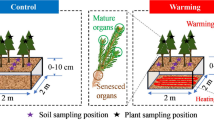Summary
The diurnal course of CO2 gas exchange, 14CO2 incorporation, malate and citrate content, and traspiration of Welwitschia mirabilis were measured in one of its natural habitats, the Welwitschia-Vlakte in the central Namib desert (Namibia), in order to decide which CO2 fixation pathway is used by this gymnosperm.
The CO2 gas exchange of Welwitschia is that of a C3 plant under arid conditions. Younger leaf parts show a two-peaked pattern of photosynthetic CO2 uptake whereas in older parts the morning peak is followed by net CO2 release during the rest of the day. The maximum rates of net photosynthesis decrease from 3.4 μmol m-2 s-1 in 1-year-old parts to 1 μmol m-2 s-1 in 7-year-old parts. No net CO2 uptake was detected during the night. The diurnal CO2 balance indicates that the old leaf parts live at the expense of the younger ones. Irrigation of Welwitschia plants resulted in an increased CO2 uptake throughout the light period with maximum rate of 4.1 μmol m-2 s-1. 14CO2 was only incorporated during the day.
The water loss of Welwitschia by transpiration is considerable, reaching a peak value of 1.9 mmol m-2 s-1 around noon. Leaf conductance corresponds with the twopeaked pattern of CO2 uptake.
Although there is no sign of a crassulacean acid metabolism in Welwitschia the leaf contains rather high amounts of malate (up to 200 μmol g-1 dry matter) and citrate (up to 250 μmol g-1 dry matter), which depend on leaf age but do not show any significant day-night oscillation.
In spite of all this the δ13C values are in the range of-17.77 to-19.64‰. Possible reasons for such a high 13C content in a C3 plant are discussed.
Similar content being viewed by others
References
Bergmeyer HU (1970) Methoden der enzymatischen Analyse. Verlag Chemie, Weinheim
Bornman CH (1972) Welwitschia mirabilis: Das widersprüchlichste Gewächs der Namib. Endeavour 31:95–99
Bornman CH, Botha CEJ, Nash LJ (1973) Welwitschia mirabilis: Observations on movement of water and assimilates under föhn and fog conditions. Madoqua Ser II 2:63–68
Dittrich P, Huber W (1974) Carbon dioxide metabolism in members of the Chlamydospermae. In: M Avron (ed), Proceedings of the Third International Congress on Photosynthesis. Elsevier, Amsterdam
Eller BM, Grobbelaar N (1982) Geophylly: Consequences for Ledebouria ovatifolia in its natural habitat. J Exp Bot 33:366–375
Farquhar GM, Ball MC, von Caemmerer S, Roksandic Z (1982) Effect of salinity and humidity on δ13C value of halophytes. Evidence for diffusional isotope fractionation determined by the ratio of intercellular/atmospheric partial pressure of CO2 under different environmental conditions. Oecologia 52:121–124
Gaff DF (1972) Drought resitance in Welwitschia mirabilis Hook. fil. Dinteria 7:3–7
Giess W (1969) Welwitschia mirabilis Hook.fil. Dinteria 3:3–55
Hanscom Z, Ting IP (1978) Irrigation magnifies CAM-photosynthesis in Opuntia basilaris (Cactaceae). Oecologia 33:1–15
Hooker JD (1863) On Welwitschia, a new genus of Gnetaceae. Trans Linn Soc NY 14:1–48
Jones MB (1975) The effect of leaf age on leaf resistance and CO2 exchange of the CAM plant Bryophyllum fedtschenkoi. Planta 123:91–96
Kers LE (1967) The distribution of Welwitschia mirabilis Hook f. Sven Bot Tidskr 61:97–125
Larcher W (1980) Ökologie der Pflanzen. E. Ulmer, Stuttgart
Neales TF (1973) The effect of night temperature and CO2 assimilation on transpiration and water use efficiency in Agave americana. L. Aust J Biol Sci 26:705–714
Osmond CB (1978) Crassulaean acid metabolism: a curiosity in context. Annu Rev Plant Physiol 29:379–414
Schmidt H-L, Winkler FJ (1979) Einige Ursachen der Variationsbreite von δ13C-Werten bei C3- und C4-Pflanzen. Ber Dtsch Bot Ges 92:185–191
Schulze E-D, Eller BM, Thomas DA, von Willert DJ, Brinckmann E (1980) Leaf temperature and energy balance of Welwitschia mirabilis in its natural habitat. Oecologia 44:258–262
Schulze E-D, Hall AE (1982) Stomatal responses, water loss and CO2 assimilation rates of plants in contrasting environments. In: Encyclopedia of plant physiology, new series, vol 12. Springer, Berlin Heidelberg New York, in press
Schulze E-D, Ziegler H, Stichler W (1976) Environmental control of Crassulacean acid metabolism, in Welwitschia mirabilis Hook.fil. in its range of natural distribution in the Namib desert. Oecologia 24:323–334
Szarek SR, Ting IP (1974) Seasonal patterns of acid metabolism and gas exchange in opuntia basilaris. Plant Physiol. 54:76–81
Walter H (1936) Die ökologischen Verhältnisse in der Namib-Nebelwüste (Südwestafrika) unter Auswertung der Aufzeichnungen des Dr. G. Boss (Swakopmund) Jahrb Wiss Bot 84:58–221
Waring RH, Running SW (1978) Sapwood water storage: its contribution to transpiration and effect upon water conductance through the stems of old-grown Douglas-fir. Plant, Cell and Environment 1:131–140
Whatley JM (1975) The occurence of a peripheral reticulum in plastids of the gymnosperm, Welwitschia mirabilis. New Phytol 74:215–220
Willert DJ von (1979) Vorkommen und Regulation des CAM bei Mittagsblumengewächsen (Mesembryanthemaceae). Ber Dtsch Bot Ges 92:133–144
Willert DJ von, Brinckmann E, Scheitler B, Thomas DA, Treichel S (1979) The activity and malate inhibition/stimulation of phosphoenolpyruvate-carboxylase in Crassulacean acid metabolism plants in their natural environment. Planta 147:31–36
Willert DJ von, Brinckmann E, Scheitler B, Schulze E-D, Thomas DA, Treichel S (1980) Ökophysiologische Untersuchungen an Pflanzen der Namib-Wüste. Naturwissenschaften 67:21–28
Willert DJ von, Brinckmann E, Scheitler B, Eller BM (1982) Responses of Crassulacean acid metabolism (CAM) to increasing and decreasing water stress in plants in the southern Namib desert. In: R. Marcelle (ed.) Stress Effects on Photosynthesis (in press)
Ziegler H (1979) Diskriminierung von Kohlenstoff- und Wasserstoffisotopen: Zusammenhänge mit dem Photosynthesemechanismus und den Standortbedingungen. Ber Dtsch Bot Ges 92:169–184
Author information
Authors and Affiliations
Additional information
Dedicated to Prof. H. Walter, the pioneer of ecophysiological studies in the Namib desert
Rights and permissions
About this article
Cite this article
von Willert, D.J., Eller, B.M., Brinckmann, E. et al. CO2 gas exchange and transpiration of Welwitschia mirabilis Hook. fil. in the central Namib desert. Oecologia 55, 21–29 (1982). https://doi.org/10.1007/BF00386713
Received:
Issue Date:
DOI: https://doi.org/10.1007/BF00386713




